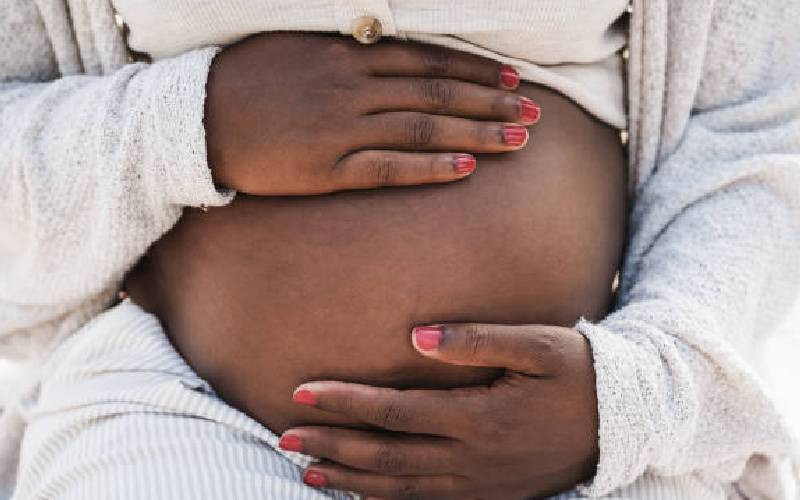
The fertility rate in Kenya has dropped, with at least half of married women not interested in childbearing.
This is according to the latest Kenya Demographic and Health Survey (2022 KDHS).
In the report released on Tuesday by the Kenya National Bureau of Statistics (KNBS) in conjunction with the Ministry of Health, the country's fertility rate stands at 3.4 per cent, a drop from 3.9 per cent, in 2014.
The fertility rate has been dropping over the years, from 6.7 per cent in 1989 to 3.4 per cent in 2022.
In 1993, Kenya had a fertility rate of 5.4 per cent, 4.7 per cent in 1998, while the rate recorded in 2003, 2008, and 2014 was 4,9, 4.6 and 3.9 respectively.
"If fertility were to remain constant at current levels, a woman in Kenya would bear an average of 3.4 children in her lifetime," read a section of the report.
Rural areas record a higher fertility rate, at 3.9 per cent, as compared to 2.8 per cent among women in urban settlements.
- KNBS report shows Nairobi women have lowest fertility rate
- Population, fertility rates drop as use of contraceptives rises
- Health survey points to disconnect with economic thinking of the day
- Nyanza counties bank on men and boys to drive anti teenage pregnancy campaigns
Keep Reading
The birth rate per 1,000 population in rural areas stood at 30.1 per cent, and 26.6 per cent in rural areas.
About 47 per cent of married women in the country, in the age bracket of between 15 and 49 years, want to have another child sooner or later, whereas 17 per cent want to have another child soon, and 30 per cent want to wait for at least two years
However, about half of married women do not want to bear children. "More than four in 10 currently married women want to limit childbearing; 43 per cent want no more children and three per cent are sterilised," added the report.
The percentage of women who were unable to conceive stood at two per cent.
The desire to have another child decreases sharply with the number of children a woman has; 88 per cent of currently married women with no children want to have a child, 66 per cent want children soon, and 22 per cent prefer to give birth within two years.
"The percentage decreases to 33 per cent among women with three children and to 16 per cent among those with six or more children," added the report.
Fertility is low among adolescents, recorded at 73 births per 1,000 women in the age bracket of between 15 and 19 years, with peaks being at 179 births per 1,000 women aged 20 to 24 years, a trend that decreases with age.
"General fertility rate per 1,000 women is 105, and 134 in rural areas," added the report.
The survey conducted last year further revealed that the use of family planning has increased over the years.
Nationally, the use of family planning in Kenya stands at 63 per cent, of which, 57 per cent represents those using modern family planning methods, whereas six per cent represents traditional methods.
Among modern family planning methods adopted by Kenyans include Injectables at 20 per cent, implants (19 per cent), pills (eight per cent), and Injectable Drug Users (IDU) at four per cent.
Counties with the highest uptake of family planning include Embu at 75 per cent, while Kirinyaga and Nyeri record 71 per cent.
Kiambu and Tharaka Nithi also have more people using contraceptives, at 68 per cent each.
Counties with the lowest uptake of family planning are Samburu (25 per cent), West Pokot (23), Tana River (23), Garissa (11), Marsabit (6), Wajir (3) and Mandera at only two per cent. The unmet need for family planning has declined from 35 per cent documented in 2014, to 14 per cent.
Skilled birth attendance has increased significantly from 66 per cent in 2014, to 89 per cent. Counties recording low attendance of skilled birth attendance are namely Turkana (53), Mandera (55), Wajir (57), Samburu (57) and Tana Rover at 59 per cent.
Compared to the past, the country has also recorded an increase in hospital deliveries and Antenatal Care (ANC).
In 2022, at least 89 per cent of women delivered babies through skilled health providers, while 82 per cent delivered in hospitals.
At least 98 per cent of women received care, of which, 66 per cent attended four ANC visits, as per international standards. To avert birth-related complications, at least 72 per cent of women received postnatal care.
"The percentage of live births in the two years preceding the survey assisted by skilled providers in 1989 was 52 per cent, followed by 1993 (43), 1998 (43) and 2003 (41).
 The Standard Group Plc is a multi-media organization with investments in media platforms spanning newspaper print
operations, television, radio broadcasting, digital and online services. The Standard Group is recognized as a
leading multi-media house in Kenya with a key influence in matters of national and international interest.
The Standard Group Plc is a multi-media organization with investments in media platforms spanning newspaper print
operations, television, radio broadcasting, digital and online services. The Standard Group is recognized as a
leading multi-media house in Kenya with a key influence in matters of national and international interest.











